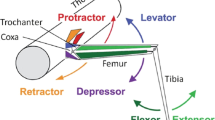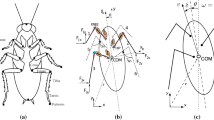Abstract
Attaching an inert mass to a freely moving tibia of an otherwise fixed stick insect Carausius morosus, induces undamped oscillations of the tibia. We describe the use of a rotational pendulum to observe these oscillations applying various amounts of inertia. The dependence of the frequency of these oscillations on the moment of inertia is similar to that of a purely mechanical system. The sequence of the oscillatory behavior can be separated into 3 distinct behavioural states. The transitions between some of these states could be elicited by external stimuli and partly showed characteristics of habituation and dishabituation. With a rotational pendulum on each middle leg, simultaneous oscillations of both legs were measured to investigate coupling effects between the neural control systems of the two legs. In some cases, significant coupling effects could be observed in phase and frequency. In many other cases, no coupling was found. The habituation and dishabituation effects were not transferred between the middle legs.
Similar content being viewed by others
References
Bässler U (1983) Neural basis of elementary behavior in stick insects. Springer, Berlin Heidelberg New York
Bässler U, Cruse H, Pflüger H-J (1974) Der Regelkreis des Kniesehnenreflexes bei der Stabheuschrecke Carausius morosus. Untersuchungen zur Stabilität des Systems im inaktiven Tier. Kybernetik 15:107–125
Batschelet E (1965) Statistical methods for the analysis of problems in animal orientation and certain biological rhythm. The Am Inst of Biol Sci, Washington
Bauer R (1987) Digitale Filter. C't, Heft 12
Büschges A (1989) Processing of sensory input from the femoral chordotonal organ by spiking interneurones of stick insects. J Exp Biol 144:81–111
Büschges A (1990) Nonspiking pathways in a joint-control loop of the stick insect Carausius morosus. J Exp Biol 151:133–160
Chatfield C (1975) Analyse von Zeitreihen. Hauser, München Wien
Kittmann R (1991) Gain control in the femur-tibia feedback system of the stick insect. J Exp Biol 157:503–522
Pflüger H-J (1977) The control of the rocking movements of the phasmid Carausius morosus. Br J Comp Physiol 120:181–202
Schlittgen R, Streitberg BHJ (1984) Zeitreihenanalyse. Oldenburg, München Wien
Stein RB (1980) Nerve and muscles, membranes, cells and systems. Plenum Press, New York London
Stein RB, Oguztöreli MN (1976) Tremor and other oscillations in neuromuscular systems. Biol Cybern 22:147–157
Storrer J, Cruse H (1977) Systemanalytische Untersuchungen eines aufgeschnittenen Regelkreises, der die Beinstellung der Stabheuschrecke Carausius morosus kontrolliert: Kraftmessungen an den Antagonisten Flexor und Extensor tibiae. Biol Cybern 25:131–142
Weiland G, Bässler U, Brunner M (1986) A biological feedback control system with electronic input: the artificially closed femur-tibia control system of stick insects. J Exp Biol 120:369–385
Author information
Authors and Affiliations
Rights and permissions
About this article
Cite this article
Pfeiffer, H.J., Koch, U.T. & Bässler, U. Mass-induced oscillations in the femur-tibia control system of stick insects. Biol. Cybern. 68, 259–266 (1993). https://doi.org/10.1007/BF00224861
Received:
Accepted:
Issue Date:
DOI: https://doi.org/10.1007/BF00224861




